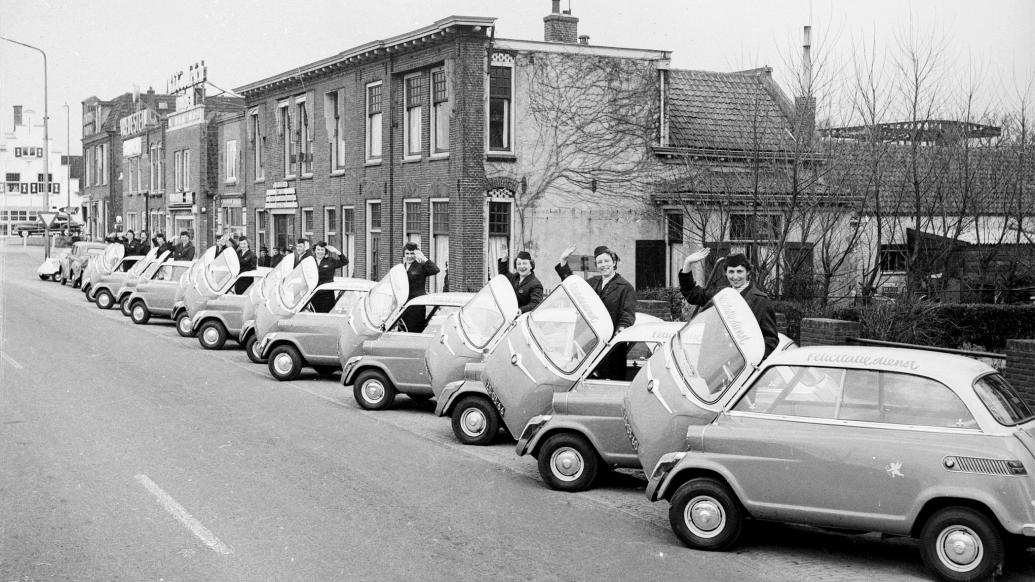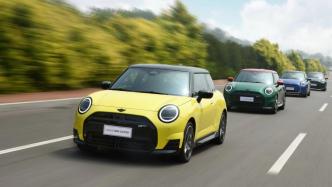
Everyone knows that MINI now belongs to BMW.
Mini was born in 1959 and it has been 65 years now. It was officially acquired by BMW in 2000, ending its precarious fate.
There is one detail that must be mentioned about Mini. Before 2000, Mini was written as Mini, and then BMW changed all four letters to capital letters, MINI. Although no one cares, it will cause a lot of inconvenience if it is not made clear, so I plan to make a statement in advance.

In April 1955, in the Netherlands, people drove their BMW 600 mini cars to send blessings and gifts to newlyweds across the Netherlands.
I don’t like cars, but I have a special liking for “small” ones. Every small car I have written about so far has its own unique power and should not be underestimated.
If I could only use one word to describe each of their personalities, I think the MX-5 should be pure, the Beetle is rebellious, and the Microlino is retro. As for the Mini, the Mini is a "small wonder", Martin Port wrote in his MINI 60th anniversary album.
The Mini may really be a miracle. Sir Issigonis, who created it, condensed his lifelong dream of small cars into an iron shell that is only ten feet long. Just thinking about this is enough to be amazing.
However, these are only later imaginations. At that time, people were only impressed by the extraordinary sense of space when sitting in it, so much so that they had an illusion that Autocar boldly wrote in the test drive draft, "Except for the mechanical part under the hood, the rest of the space belongs to you and your suitcase."
This is the essence of Mini. In order to maximize the space utilization in the small car, Issigonis placed the Mini's engine horizontally, reduced the tires to 10 inches, rearranged the positions of the gearbox and fuel tank, and adopted a four-wheel independent suspension with rubber material. It was like manipulating magic to create the most sophisticated mechanical structure for Mini, and you can never imagine that it is hidden in such a petite body.
Issigonis poured all his enthusiasm and ambition into Mini, and of course his selfishness was also part of it. It is said that Issigonis painstakingly designed the storage space to satisfy his own alcohol addiction. The front side door was just big enough to hold his favorite Gordon's gin, and the wine glasses and tonic water could be stuffed completely under the back seat. How credible this rumor is, of course, unknown, but the Dry Martini is indeed a cocktail with gin as the base liquor, and it is Issigonis' favorite, and this is the only thing that is absolutely true.
Of course, Issigonis was drinking wine even when he drew the first sketch of the Mini on the tablecloth. Issigonis became famous because of the Mini. Although his first two works, Lightweight Special and Morris Minor, are not as well-known as Mini, they are obviously more respected in the industry. Lightweight, as Issigonis's debut work, has its own preciousness, and Morris Minor, as the first British car to sell more than one million, its status can also be seen.
But it's hard to agree on the Mini's value.
From a business perspective, it was a failure in Issigonis' career and the beginning of a company's nightmare. In the 1960s, British Motor Corporation lost 30 pounds for every Mini sold, while it could make about 40 pounds for every Morris Minor sold. Even in 1962, when the high-end version of Mini accounted for 90% of total sales, Mini still did not make money. All the problems stemmed from its pricing. It was too cheap, so cheap that some people were deterred from buying it. In 1959, the starting price of Mini was 350 pounds, and with tax it was only 497 pounds, less than 500 pounds, while the low-end models of competitors were more than 500 pounds. Even a four-seater Mini was more than 100 pounds cheaper than a BMW Isetta 600, which could not be called a car with three wheels or two seats.
In this way, it seems a bit exaggerated to directly translate wonder into miracle to describe Mini. I thought for a long time how to use wonder to explain the charm of Mini. Until last weekend, I was sitting in Ippudo waiting for ramen, and I happened to see a line of small words printed on the poster on the wall, Japanese wonder to the world. Can a common ramen restaurant create miracles? I thought at the time. Later, I saw the founder Kawahara Shigemi said in some reports about Ippudo that Ippudo wants to be the wind of change. The environment of the previous ramen restaurants was not satisfactory, so Kawahara Shigemi wanted to create a good place for people to eat ramen, so that girls would also be willing to go.
Mini is probably the wind. Ippudo is not the best ramen restaurant, and Mini is not the best car, but they are like a gust of wind that pushes things in a new direction. Mini made front-wheel drive cars popular, and its shadow can be found in many small cars later.
However, Issigonis had no intention of making Mini a trend. This paranoid man never listened, and was even more deaf to market demands. When someone complained that the seats were uncomfortable, he simply said that it was to keep you awake enough while driving. He rejected John Cooper's request to send Mini to the track, and told John that Mini could only be a family car. He hated fashion and arrogantly told his Italian friend that in two years, your car would be outdated as quickly as women's clothes, but mine would not.
But in the end, it was precisely those things that Issigonis hated and rejected that continued the life of Mini. From 1959 to 2000, Mini went through several rounds of changes of ownership. In 1994, BMW acquired Rover, and Mini once again came to a fork in the road of fate. No one wanted to keep Mini, except for the then CEO Bernd Pischertschröder, who finally convinced everyone. Although Mini was old when BMW took over, what remained in his heart was always the Mini in the Monte Carlo Rally in the 1960s, full of vigor and invincibility. For him and all his friends, being able to own a Mini Cooper was more important than anything else.
Issigonis had no intention, but BMW intended to make MINI popular. In 2000, BMW sold Rover but kept Mini. The new era of MINI began a grand and gorgeous adventure. Under BMW's packaging, MINI became popular again, pushing the small car culture to an unprecedented height.
No one will admit that the Mini before 2000 and the MINI after 2000 are the same thing. But it is the latter that impresses people. The fashionable, avant-garde and modern MINI is all given by BMW and has little to do with Issigonis.
In 1959, Mini was born. Issigonis gave it its first life. After 2000, BMW gave MINI a second life. For the rest of the time, Mini has always been in popular culture. So, in the next article, I think maybe we should talk about why Mini is the coolest little car.
